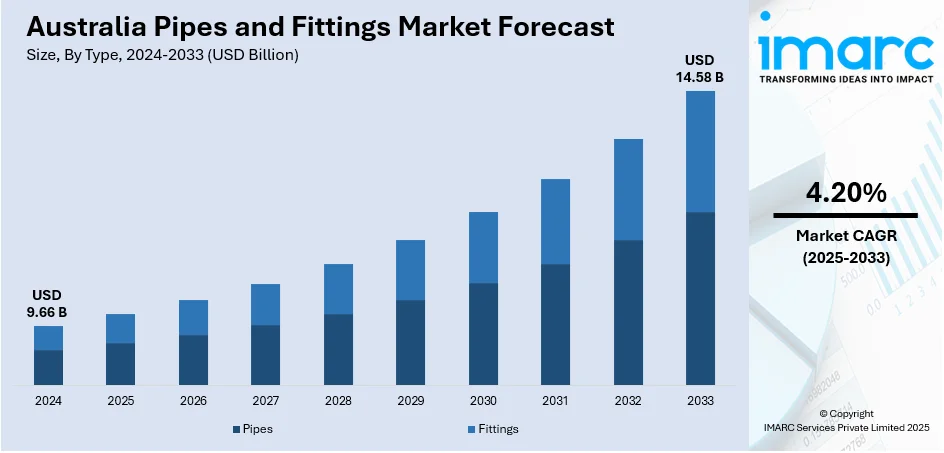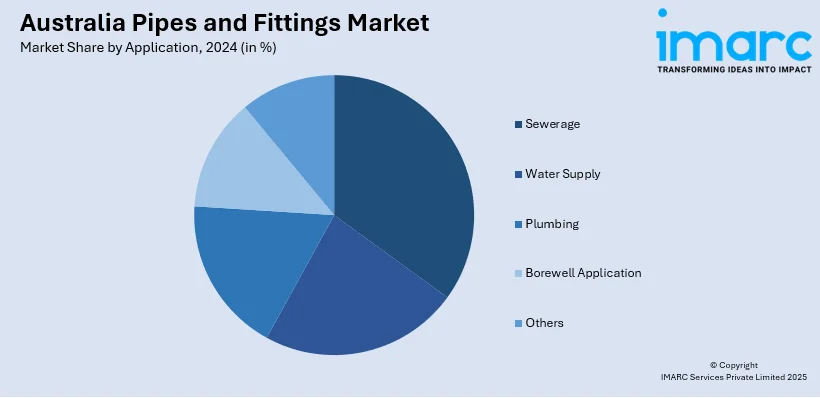
Australia Pipes and Fittings Market Size, Share, Trends and Forecast by Type, Technology, Application, Vertical, and Region, 2025-2033
Australia Pipes and Fittings Market Size and Share:
The Australia pipes and fittings market size reached USD 9.66 Billion in 2024. Looking forward, IMARC Group expects the market to reach USD 14.58 Billion by 2033, exhibiting a growth rate (CAGR) of 4.20% during 2025-2033. The market is transforming with greater use of thermoplastic materials, smart technologies integration, and growing infrastructure development. These drivers are fueled by requirements for durability, operating efficiency, and green building practices in residential, commercial, and industrial segments. Material science and digital monitoring advancements are facilitating more efficient systems at reduced lifecycle costs. Ongoing urbanization and investments in public infrastructure also are speeding up market growth, together driving the rising Australia pipes and fittings market share.
|
Report Attribute
|
Key Statistics
|
|---|---|
|
Base Year
|
2024 |
|
Forecast Years
|
2025-2033
|
|
Historical Years
|
2019-2024
|
| Market Size in 2024 | USD 9.66 Billion |
| Market Forecast in 2033 | USD 14.58 Billion |
| Market Growth Rate 2025-2033 | 4.20% |
Australia Pipes and Fittings Market Trends:
Growing Application of Thermoplastic Materials for Piping Solutions
Thermoplastic materials are experiencing increased use within the Australia pipes and fittings sector due to their long service life, corrosion resistance, and light weight properties. Polymers like polyvinyl chloride (PVC) chlorinated polyvinyl chloride (CPVC), and high-density polyethylene (HDPE) are highly being used to replace conventional metallic pipes in various applications in water supply, sewage, and irrigation. For instance, in July 2024, Standards Australia launched AS/NZS 5395, the world's first global standard for Best Environmental Practice PVC pipes and fittings, to enable safety, sustainability, and circular economy. Furthermore, their potential to resist severe environmental conditions and chemical exposure without undergoing degradation renders them suitable for long-term infrastructure planning. In addition, innovations in extrusion and molding technologies are allowing complex thermoplastic fittings to be produced with higher accuracy and reliability. These products are also inexpensive and simpler to install, resulting in reduced labor and maintenance expenses throughout the project life. Since sustainability and lifecycle cost concerns gain importance in public and private building, thermoplastics are likely to dominate future installations. This choice of material is one of the key Australia pipes and fittings market trends driving market growth in residential, commercial, and municipal space.

To get more information on this market, Request Sample
Integration of Smart Piping Systems into Infrastructure Projects
The use of smart piping systems, which are implanted with sensors and IoT-based monitoring technologies, is revolutionizing the management of piping infrastructure in Australia. The systems enable real-time monitoring of flow rate, pressure, and leakage levels, which greatly enhances operational efficiency and maintenance planning. Intelligent valves, with data analytics platforms, enable predictive maintenance and minimize the risk of expensive failure in industrial and municipal applications. This move towards digitalization is consistent with Australia's overall aspirations for smart cities and advanced technology-based infrastructure. In industries such as chemical processing, HVAC, and irrigation, such systems facilitate optimized resource usage, promoting sustainability and minimizing environmental footprint. The pressure to digitize is spurring innovation in all fittings and pipe production processes, from design to deployment. Intelligent monitoring capability has become the pivotal industry driver for Australia pipes and fittings market growth and represents a change-over period in market trends.
Increased Infrastructure Development and Urban Growth
Australia's increasing investments in the development of infrastructure, such as urban utilities, transport systems, and smart cities, are fueling the need for strong and reliable pipes and fittings solutions. The industry is witnessing high growth in both residential and municipal projects, particularly for water distribution lines, sewage systems, and stormwater management. According to the reports, in April 2024, Australia's Anti-Dumping Commission initiated a review on Chinese stainless steel sinks, which could impact the pipes and fittings industry, with final recommendations due by November 2024. Moreover, urban growth in Sydney, Melbourne, and Brisbane is increasingly driving the requirement for modern plumbing and piping systems that meet the latest safety and efficiency standards. The demand is also present in high-rise commercial towers and industrial plants for sophisticated fittings used in HVAC and process instrumentation applications. The move towards eco-friendly and energy-efficient building practices also promotes the adoption of newer piping technologies with a low environmental footprint. This infrastructure-led growth is being a key driver of fueling Australian market growth and shaping trends towards innovation, standardization, and system solutions in the integrated form in public as well as private sector projects.
Australia Pipes and Fittings Market Segmentation:
IMARC Group provides an analysis of the key trends in each segment of the market, along with forecasts at the country and regional levels for 2025-2033. Our report has categorized the market based on type, technology, application, and vertical.
Type Insights:
- Pipes
- Plastic Pipes
- Metallic Pipes
- Others
- Fittings
- Elbow
- Reducer
- Tee Type
- Cross Type
- Coupling
- Union
- Adaptor
- Valve
- Cap
- Others
The report has provided a detailed breakup and analysis of the market based on the type. This includes pipes (plastic pipes, metallic pipes, and others), and fittings (elbow, reducer, tee type, cross type, coupling, union, adaptor, valve, cap, and others).
Technology Insights:
- Compression Molding
- Injection Molding
- Thermoforming
- Extrusion
- Electro Fusion
- Fabricated
- Others
A detailed breakup and analysis of the market based on the technology have also been provided in the report. This includes compression molding, injection molding, thermoforming, extrusion, electro fusion, fabricated, and others.
Application Insights:

- Sewerage
- Water Supply
- Plumbing
- Borewell Application
- Others
The report has provided a detailed breakup and analysis of the market based on the application. This includes sewerage, water supply, plumbing, borewell application, and others.
Vertical Insights:
- Chemical and Petrochemical
- Residential
- Commercial
- Transportation
- Municipal
- Food and Beverage
- Oil and Gas
- Power
- Process Instrumentation
- Semiconductor
- Irrigation
- HVAC
- Others
A detailed breakup and analysis of the market based on the vertical have also been provided in the report. This includes chemical and petrochemical, residential, commercial, transportation, municipal, food and beverage, oil and gas, power, process instrumentation, semiconductor, irrigation, HVAC, and others.
Regional Insights:
- Australia Capital Territory & New South Wales
- Victoria & Tasmania
- Queensland
- Northern Territory & Southern Australia
- Western Australia
The report has also provided a comprehensive analysis of all the major regional markets, which include Australia Capital Territory & New South Wales, Victoria & Tasmania, Queensland, Northern Territory & Southern Australia, and Western Australia.
Competitive Landscape:
The market research report has also provided a comprehensive analysis of the competitive landscape. Competitive analysis such as market structure, key player positioning, top winning strategies, competitive dashboard, and company evaluation quadrant has been covered in the report. Also, detailed profiles of all major companies have been provided.
Australia Pipes and Fittings Market News:
- In May 2025, Poly Pipe News (PPN) showcased Georg Fischer's \$200 million takeover of VAG Group, unveiled fresh findings on microplastics emitted by old PVC pipes, announced Atkore's \$128 million write-down in HDPE pipes, and reported on Borouge's Q1 profit expansion, continuing its market leadership in news on polymer pipe industry.
Australia Pipes and Fittings Market Report Coverage:
| Report Features | Details |
|---|---|
| Base Year of the Analysis | 2024 |
| Historical Period | 2019-2024 |
| Forecast Period | 2025-2033 |
| Units | Billion USD |
| Scope of the Report |
Exploration of Historical Trends and Market Outlook, Industry Catalysts and Challenges, Segment-Wise Historical and Future Market Assessment:
|
| Types Covered |
|
| Technologies Covered | Compression Molding, Injection Molding, Thermoforming, Extrusion, Electro Fusion, Fabricated, Others |
| Applications Covered | Sewerage, Water Supply, Plumbing, Borewell Application, Others |
| Verticals Covered | Chemical and Petrochemical, Residential, Commercial, Transportation, Municipal, Food and Beverage, Oil and Gas, Power, Process Instrumentation, Semiconductor, Irrigation, HVAC, Others |
| Regions Covered | Australia Capital Territory & New South Wales, Victoria & Tasmania, Queensland, Northern Territory & Southern Australia, Western Australia |
| Customization Scope | 10% Free Customization |
| Post-Sale Analyst Support | 10-12 Weeks |
| Delivery Format | PDF and Excel through Email (We can also provide the editable version of the report in PPT/Word format on special request) |
Key Questions Answered in This Report:
- How has the Australia pipes and fittings market performed so far and how will it perform in the coming years?
- What is the breakup of the Australia pipes and fittings market on the basis of type?
- What is the breakup of the Australia pipes and fittings market on the basis of technology?
- What is the breakup of the Australia pipes and fittings market on the basis of application?
- What is the breakup of the Australia pipes and fittings market on the basis of vertical?
- What is the breakup of the Australia pipes and fittings market on the basis of region?
- What are the various stages in the value chain of the Australia pipes and fittings market?
- What are the key driving factors and challenges in the Australia pipes and fittings?
- What is the structure of the Australia pipes and fittings market and who are the key players?
- What is the degree of competition in the Australia pipes and fittings market?
Key Benefits for Stakeholders:
- IMARC’s industry report offers a comprehensive quantitative analysis of various market segments, historical and current market trends, market forecasts, and dynamics of the Australia pipes and fittings market from 2019-2033.
- The research report provides the latest information on the market drivers, challenges, and opportunities in the Australia pipes and fittings market.
- Porter's five forces analysis assist stakeholders in assessing the impact of new entrants, competitive rivalry, supplier power, buyer power, and the threat of substitution. It helps stakeholders to analyze the level of competition within the Australia pipes and fittings industry and its attractiveness.
- Competitive landscape allows stakeholders to understand their competitive environment and provides an insight into the current positions of key players in the market.
Need more help?
- Speak to our experienced analysts for insights on the current market scenarios.
- Include additional segments and countries to customize the report as per your requirement.
- Gain an unparalleled competitive advantage in your domain by understanding how to utilize the report and positively impacting your operations and revenue.
- For further assistance, please connect with our analysts.
 Request Customization
Request Customization
 Speak to an Analyst
Speak to an Analyst
 Request Brochure
Request Brochure
 Inquire Before Buying
Inquire Before Buying




.webp)




.webp)












